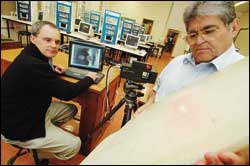Researchers aim high with new project
30 October 2006
High flyers: Dirk Findeis and Prof Jasson Gryzagoridis have designed a new device to test modern-day aircraft materials.
Dirk Findeis and Professor Jasson Gryzagoridis have dedicated the past seven years to the development of a portable, non-destructive testing device for aircraft materials, using digital shearography.
Digital shearography uses a laser to illuminate an object under inspection. The laser light reflected off the object is imaged through a shearing device - which splits the image in two - and collected by a high-resolution digital camera.
To use this technique to inspect materials for defects, the object needs to be put under stress by, for example, heating it mildly with a hair drier or a lamp. When the object is stressed, its surface deforms, enabling the shearing device to pick up defects such as debonds, sub-surface cracks and impact damage in space-age materials like composites of Monex (honeycomb) core and carbon- or glass fibre-reinforced plastic skin.
Images taken before stressing are compared to images taken during stressing, with special software enabling the interpretation and visualisation of the resulting images at virtually real time.
The new UCT Digital Shearography Prototype 3, developed by Findeis and Gryzagoridis, based in the Non-Destructive Testing Laboratory in the Department of Mechanical Engineering, allows for the inspection and evaluation of an object without physical contact or permanent deformation, damage or any other unwanted effect.
"By just looking at the surface if there is a sub-surface defect, it will reveal itself in the displacement field of the surface," says Findeis. "Only minimal surface deformation is required in order for the device to pick it up. "
Current aircraft testing methods include the use of dye-penetrants, x-rays and ultrasound. However, says Findeis, with the increased use of composite materials, digital shearography is potentially better suited to the job. Dye-penetrants and x-rays cannot detect delaminations in composites, and ultrasound requires a probe to be scanned over the entire area to be tested. The high level of attenuation of the ultrasound signal in composites complicates matters further.
Findeis and Gryzagoridis exhibited their portable inspection system at the recent Africa Aerospace and Defence Exhibition and Air Show at the Ysterplaat Air Force Base in Cape Town. Not only did they put UCT on the 2006 exhibition list, of all the tertiary institutions exhibiting "we were the only ones with a finished product", Gryzagoridis said.
With their device commercially available, they have sold one to the Council for Scientific and Industrial Research (CSIR), the largest science and technology research organisation linked with industry in South Africa.
"Airbus has asked us for a quotation," Gryzagoridis adds.
"It is state-of-the-art equipment for the current and future testing of aerospace materials."
Every aircraft comes with a safety and maintenance manual, specifying devices, techniques and procedures that must be followed, says Findeis. "The challenge is to get digital shearography specified in the manuals as a certified testing technique."
 This work is licensed under a Creative Commons Attribution-NoDerivatives 4.0 International License.
This work is licensed under a Creative Commons Attribution-NoDerivatives 4.0 International License.
Please view the republishing articles page for more information.










